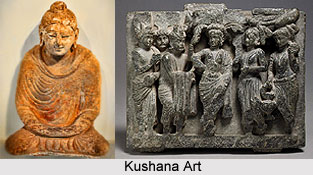 Kushana art is the defining style of the Mathura school of art. In the history of Mathura, it was during the time of Saka-Ksatrapa rulers that local people came into contact with foreigners. But more than the Sakas, the Kushanas were responsible for the deep-rooted foreign influence that is noticeable in the local art and traditions. New rulers, new environments and traditions seem to be the factors which ushered in a news school of art- the Kushana art. This was the period when Kushana art reached a ripe stage and all of its characteristics were fully evolved. Images of all three sects- Jainism, Vaishnavism and Buddhism- were carved and handled with equal skill.
Kushana art is the defining style of the Mathura school of art. In the history of Mathura, it was during the time of Saka-Ksatrapa rulers that local people came into contact with foreigners. But more than the Sakas, the Kushanas were responsible for the deep-rooted foreign influence that is noticeable in the local art and traditions. New rulers, new environments and traditions seem to be the factors which ushered in a news school of art- the Kushana art. This was the period when Kushana art reached a ripe stage and all of its characteristics were fully evolved. Images of all three sects- Jainism, Vaishnavism and Buddhism- were carved and handled with equal skill.
The sculptures of this period can be divided into the following categories- Jaina Tirthankara Figures; Jaina Tablets of homage (Ayayapattas); Figures of Gautama Buddha and the Boddhisattavas; Images of Brahmanical deities; images of the semi-celestial deities like Yakshas, Yakshinis, Nagas and the Bacchanalian scenes; Stone Slabs showing different stories and episodes; Railing pillars, cross bars, door lintels, door jambs, grills etc; and statues of Kushana kings. The image of the Buddha is an assemblage of a Hellenistic Buddha statue with feet represented and spread apart in the same fashion as that of the Kushan king.
The features of Kushana Art are briefly discussed below.
1. Powerful depictions of human beings indulging in multifarious activities.
2. Development in style and technique of carving figures.
3. New methods of narrating long and continuous stories.
4. Effective combination of old and new motifs.
5. Influence of Gandhara art.
6. Appearance of images of the Buddha, Tirthankaras and different Brahmanical deities.
7. Introduction of portrait sculpture.
Several depictions of Kushans are known from Gandhara. During Kushan Empire, many images of Gandhara had similarities to the features of Greek, Syrian, Persian and Indian figures. Kushans introduced a mixed culture that is best illustrated by the variety of deities-Greco-Roman, Iranian, and Indian. Two major stylistic divisions can be made among artifacts of the period: imperial art of Iranian derivation and Buddhist art of mixed Greco-Roman and Indian sources. The style of Kushan artworks is stiff, hieratic, and frontal. It emphasizes the power and wealth of the individual. There is no interest in the rendering of anatomy or drapery.



